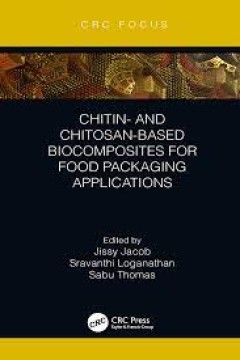Filter by

Application of Lactobacillus Rhamnosus gg Incorporated with Orange Peel Powde…
There is a growing interest in developing edible films made from natural biopolymers that are favored to enhance the quality of food packaging and meet the demand for sustainable food packaging solutions. This study involved creating a Gelatin-Chitosan (GC) edible film incorporating Lactobacillus rhamnosus GG (LGG) as probiotics to benefit customers' health. Moreover, different concentration…
- Edition
- -
- ISBN/ISSN
- -
- Collation
- -
- Series Title
- -
- Call Number
- FT 24-029

Optimization and Characterization of 3D Printed Edible Film Based On Differen…
In modern times, consumers are increasingly choosing food packaging that is high quality and sustainable to ensure the safety of the food and minimizing the use of non-recyclable materials that cause negative impact on the ecosystem. As a result, edible film is becoming more popular to improve the quality and safety of food. 3D printing technology offers excellent capability and potential in…
- Edition
- -
- ISBN/ISSN
- -
- Collation
- -
- Series Title
- -
- Call Number
- FT 24-011

Cytotoxicity test for Hydroxyapatite-HPMC-Chitosan Injectable Bone Graft: A S…
This systematic review both serves as the author’s experience as an intern at Badan Riset dan Inovasi Nasional (BRIN), in the department of Pusat Riset Materi Maju (PRMM), under the guidance of Dr. Nendar Herdianto, M. Si, while being a substitute for a normal internship report. The goal of this internship was to create a systematic review that compiles the previous researches and discusses t…
- Edition
- -
- ISBN/ISSN
- -
- Collation
- -
- Series Title
- -
- Call Number
- BM-001

Gelatin-Chitosan Edible Film with Kesum Extracts: Evaluation of Physical, Mec…
The utilization of edible film has gained much attention in food packaging development and industry due to its potential to preserve food and biodegradability, which could reduce environmental waste compared to conventional food packaging. Moreover, the application of pure polymers has shown insufficient defense against microbial deterioration; thus, the incorporation of plant-derived secon…
- Edition
- -
- ISBN/ISSN
- -
- Collation
- -
- Series Title
- -
- Call Number
- BT 23-026

Effect of Chitosan-Gelatin Edible Film Incorporated with Kesum Leaves Extract…
Beef has been a staple food for mankind and its consumption has been in an uptrend throughout the years as it is a common source of protein, while also containing a lot of polyunsaturated fats, high in water content, and other nutrients, all of which are the main cause of beef spoilage, namely, the breakdown of protein, lipid oxidation, and microbial infestation. To extend the shelf life of …
- Edition
- -
- ISBN/ISSN
- -
- Collation
- -
- Series Title
- -
- Call Number
- BT 23-023

The influence of potassium chloride and chitosan on the appearance, odor, tex…
Maintaining food safety is crucial for the health and well-being of individuals. By incorporating food-grade KCl and Chitosan, the antimicrobial properties of food can be significantly improved, leading to better overall health for consumers. That is why this project focuses on studying and investigating their effects on the growth of Salmonella spp. in chicken meat and includes a sensory a…
- Edition
- -
- ISBN/ISSN
- -
- Collation
- -
- Series Title
- -
- Call Number
- FT 23-029

Effect Of Chitosan-Based Films With Commercially Available Pandanus conoideus…
With the rising demand of convenient and readily-available food products along with consumer awareness of detrimental effects of excessive plastic usage and food waste, more interest has developed in bio-film packaging as a means to assist in decreasing the number of waste produced, both environmentally and food-wise. The main aim of this study is to observe the potential prolonging of shel…
- Edition
- -
- ISBN/ISSN
- -
- Collation
- -
- Series Title
- -
- Call Number
- FT 22-009

Development of Chitosan Film Incorporated with Cubeb Essential Oil (Piper Cub…
The susceptibility of meat to quality and safety issues has brought numerous attempts to incorporate antioxidants and antimicrobial agents into the packaging to improve the shelf stability of meat. The study aims to develop chitosan film incorporated with Piper Cubeba essential oil (PCO) into chitosan film to improve the shelf life of beef shank cuts. 2% (w/v) chitosan films with 0-3% PCO we…
- Edition
- -
- ISBN/ISSN
- -
- Collation
- -
- Series Title
- -
- Call Number
- FT 22- 007

Pectin-Based Drug Delivery System : Targeting Colorectal Cancer
The ease of access to food in our era has come with a risk of unhealthy lifestyle, giving rise to numerous health problems, including colorectal cancer (CRC). However, the development of cancer chemotherapy has been outpaced by the swift growth of CRC prevalence. The harsh side effects still become the primary reason for the low patient compliance, which may be minimized by limiting the drug ac…
- Edition
- -
- ISBN/ISSN
- -
- Collation
- -
- Series Title
- -
- Call Number
- PHA 21-004

Chitin-and chitosan-based biocomposites for food packaging applications
This book focuses on composition, properties, characterization, and theoretical approach of chitin and chitosan bio-composites. It describes the most recent studies concerning chitin and chitosan-based films and gives an overview about future trends regarding the industrial applications of chitin and chitosan for food packaging purposes
- Edition
- -
- ISBN/ISSN
- 9780367280901
- Collation
- ix, 98 p. : ill. : ind. ; 22 cm.
- Series Title
- -
- Call Number
- 664.090284 Chi
 Computer Science, Information & General Works
Computer Science, Information & General Works  Philosophy & Psychology
Philosophy & Psychology  Religion
Religion  Social Sciences
Social Sciences  Language
Language  Pure Science
Pure Science  Applied Sciences
Applied Sciences  Art & Recreation
Art & Recreation  Literature
Literature  History & Geography
History & Geography